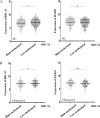Aberrant Regulation of RAD51 Promotes Resistance of Neoadjuvant Endocrine Therapy in ER-positive Breast Cancer
- PMID: 31506496
- PMCID: PMC6736845
- DOI: 10.1038/s41598-019-49373-w
Aberrant Regulation of RAD51 Promotes Resistance of Neoadjuvant Endocrine Therapy in ER-positive Breast Cancer
Abstract
Breast cancer is one of the most common malignant cancers affecting females. Estrogen receptor (ER)-positive breast cancer is responsive to endocrine therapy. Although current therapies offer favorable prospects for improving survival, the development of resistance remains a severe problem. In this study, we explored the resistance mechanisms of ER-positive breast cancer to neoadjuvant endocrine therapy. Microarray data of GSE87411 contained 109 pairs of samples from Z1031 trial, including untreated samples and post-treated samples with neoadjuvant aromatase inhibitor (AI) therapy. The differentially expressed genes (DEGs) were obtained from two different comparisons: untreated samples versus post-treated samples with AIs, and post-treated samples sensitive versus resistant to AIs. Multiple bioinformatic methods were applied to evaluate biological function, protein-protein network and potential binding between target protein and aromatase inhibitor. Then, regulation of gene expression, DNA methylation and clinicopathological factors of breast cancer were further analyzed with TCGA data. From GSE87411 dataset, 30 overlapped DEGs were identified. Cell division was found to be the main function of overlapped DEGs by functional enrichment and gene ontology (GO) analysis. RAD51 recombinase (RAD51), a key protein of homologous recombination, was detected to interact with BReast CAncer genes 2 (BRCA2). Moreover, according to the docking simulation, RAD51 might potentially bind to AIs. Overexpressed RAD51 was associated with hypermethylation of BRCA2, resistance to AIs and poor overall survival of patients with ER-positive breast cancer. Furthermore, RAD51 was found to be a better indicator than MKI67 for predicting resistance in neoadjuvant setting. The results indicated that methylation of BRCA2 led to incomplete suppression on RAD51, which caused an increased expression of RAD51, subsequently AI-resistance and poor prognosis in ER-positive breast cancer. RAD51 could be a new candidate used as a predicative marker and therapeutic target in neoadjuvant endocrine treatment.
Conflict of interest statement
The authors declare no competing interests.
Figures






Similar articles
-
Candidate methylation sites associated with endocrine therapy resistance in ER+/HER2- breast cancer.BMC Cancer. 2020 Jul 19;20(1):676. doi: 10.1186/s12885-020-07100-z. BMC Cancer. 2020. PMID: 32684154 Free PMC article.
-
Integrative analyses identify modulators of response to neoadjuvant aromatase inhibitors in patients with early breast cancer.Breast Cancer Res. 2015 Mar 11;17(1):35. doi: 10.1186/s13058-015-0532-0. Breast Cancer Res. 2015. PMID: 25888249 Free PMC article.
-
Down-regulation of programmed cell death 4 (PDCD4) is associated with aromatase inhibitor resistance and a poor prognosis in estrogen receptor-positive breast cancer.Breast Cancer Res Treat. 2015 Jul;152(1):29-39. doi: 10.1007/s10549-015-3446-8. Epub 2015 May 31. Breast Cancer Res Treat. 2015. PMID: 26026468 Free PMC article.
-
Structural and functional characterization of aromatase, estrogen receptor, and their genes in endocrine-responsive and -resistant breast cancer cells.J Steroid Biochem Mol Biol. 2016 Jul;161:73-83. doi: 10.1016/j.jsbmb.2015.07.018. Epub 2015 Aug 13. J Steroid Biochem Mol Biol. 2016. PMID: 26277097 Free PMC article. Review.
-
The development, application and limitations of breast cancer cell lines to study tamoxifen and aromatase inhibitor resistance.J Steroid Biochem Mol Biol. 2012 Sep;131(3-5):83-92. doi: 10.1016/j.jsbmb.2011.12.005. Epub 2012 Jan 8. J Steroid Biochem Mol Biol. 2012. PMID: 22265958 Free PMC article. Review.
Cited by
-
Curcumin sensitizes carboplatin treatment in triple negative breast cancer through reactive oxygen species induced DNA repair pathway.Mol Biol Rep. 2022 Apr;49(4):3259-3270. doi: 10.1007/s11033-022-07162-1. Epub 2022 Jan 25. Mol Biol Rep. 2022. PMID: 35076853
-
Neoadjuvant endocrine therapy in locally advanced estrogen or progesterone receptor-positive breast cancer: determining the optimal endocrine agent and treatment duration in postmenopausal women-a literature review and proposed guidelines.Breast Cancer Res. 2020 Jul 20;22(1):77. doi: 10.1186/s13058-020-01314-6. Breast Cancer Res. 2020. PMID: 32690069 Free PMC article. Review.
-
Homologous recombination DNA repair gene RAD51, XRCC2 & XRCC3 polymorphisms and breast cancer risk in South Indian women.PLoS One. 2022 Jan 21;17(1):e0259761. doi: 10.1371/journal.pone.0259761. eCollection 2022. PLoS One. 2022. PMID: 35061678 Free PMC article.
-
A novel group of genes that cause endocrine resistance in breast cancer identified by dynamic gene expression analysis.Oncotarget. 2022 Apr 6;13:600-613. doi: 10.18632/oncotarget.28225. eCollection 2022. Oncotarget. 2022. PMID: 35401937 Free PMC article.
-
Understanding Rad51 function is a prerequisite for progress in cancer research.QRB Discov. 2020 Oct 26;1:e9. doi: 10.1017/qrd.2020.13. eCollection 2020. QRB Discov. 2020. PMID: 37528958 Free PMC article.
References
-
- Burstein HJ, et al. American Society of Clinical Oncology clinical practice guideline: update on adjuvant endocrine therapy for women with hormone receptor-positive breast cancer. Journal of clinical oncology: official journal of the American Society of Clinical Oncology. 2010;28:3784–3796. doi: 10.1200/JCO.2009.26.3756. - DOI - PMC - PubMed
Publication types
MeSH terms
Substances
LinkOut - more resources
Full Text Sources
Medical
Research Materials
Miscellaneous

